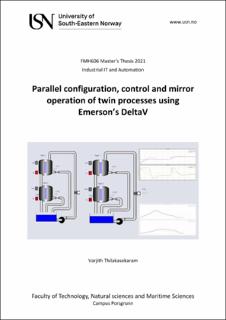| dc.contributor.advisor | Pfeiffer, Carlos F. | |
| dc.contributor.author | Thilakasekaram, Varjith | |
| dc.date.accessioned | 2021-08-05T16:12:13Z | |
| dc.date.available | 2021-08-05T16:12:13Z | |
| dc.date.issued | 2021 | |
| dc.identifier | no.usn:wiseflow:2680012:44163523 | |
| dc.identifier.uri | https://hdl.handle.net/11250/2766577 | |
| dc.description.abstract | The University of South-Eastern Norway has two identical Serial Two Tank systems, a first-order system with time delay. Identical twin processes are systems built with identical physical components. These identical systems were tested to configure in parallel and to mirror their performance identical to each other. As the first step, one process was taken as the primary process and tuned using the Skogestad PI tuning rule in MATLAB Simulink. Then the tuned controller parameters were used on both systems, and the outputs were compared. Moreover, to adapt both systems, the systems models were developed using the 1st principles theory. As some of the model parameters were not calculated experimentally, the models' parameters were tuned using an optimization algorithm.
The secondary process was configured using Emerson’s DCS system. The configured system was simulated for a step-change in a closed-loop using the controller parameters gained for the primary system. The result showed that even though identical system dynamics will not be the same as each other. As for limited resources, the secondary system also connected with MATLAB Simulink for further experiments. Therefore, both primary and secondary systems were connected with MATLAB Simulink as the controller system. The simulation of both system with tuned parameters showed a need to optimize the secondary process controller parameters to mirror each other.
The secondary controller parameters were optimized using the LMAC (Learning Model Adaptive Control) and MRAC (Model Reference Adaptive Control) techniques. For the LMAC theory, the mathematical model of the secondary process was used to tune the controller parameter. For the MRAC, the controller parameter was tuned using the MIT rule of gradient descent. Moreover, the controller parameters also optimized using the error between the process input as the cost function.
The results showed that the mathematical model of the respective processes behaves in the same order but exists errors, even after the model parameters were tuned, which leads to conclude that the parameters' values even after tuning were not global minimum rather than a local minimum.
The optimization of the controller parameter using the model showed that this technique is possible only if the mathematical model accurately represents the real process to match the processes outputs to mirror each other. The MIT rule results showed that it is possible to reduce the error between the process outputs and follow one of the process outputs. It is concluded that using the MRAC technique, two identical models can be configured in parallel, and outputs can be mirrored. | |
| dc.description.abstract | The University of South-Eastern Norway has two identical Serial Two Tank systems, a first-order system with time delay. Identical twin processes are systems built with identical physical components. These identical systems were tested to configure in parallel and to mirror their performance identical to each other. As the first step, one process was taken as the primary process and tuned using the Skogestad PI tuning rule in MATLAB Simulink. Then the tuned controller parameters were used on both systems, and the outputs were compared. Moreover, to adapt both systems, the systems models were developed using the 1st principles theory. As some of the model parameters were not calculated experimentally, the models' parameters were tuned using an optimization algorithm.
The secondary process was configured using Emerson’s DCS system. The configured system was simulated for a step-change in a closed-loop using the controller parameters gained for the primary system. The result showed that even though identical system dynamics will not be the same as each other. As for limited resources, the secondary system also connected with MATLAB Simulink for further experiments. Therefore, both primary and secondary systems were connected with MATLAB Simulink as the controller system. The simulation of both system with tuned parameters showed a need to optimize the secondary process controller parameters to mirror each other.
The secondary controller parameters were optimized using the LMAC (Learning Model Adaptive Control) and MRAC (Model Reference Adaptive Control) techniques. For the LMAC theory, the mathematical model of the secondary process was used to tune the controller parameter. For the MRAC, the controller parameter was tuned using the MIT rule of gradient descent. Moreover, the controller parameters also optimized using the error between the process input as the cost function.
The results showed that the mathematical model of the respective processes behaves in the same order but exists errors, even after the model parameters were tuned, which leads to conclude that the parameters' values even after tuning were not global minimum rather than a local minimum.
The optimization of the controller parameter using the model showed that this technique is possible only if the mathematical model accurately represents the real process to match the processes outputs to mirror each other. The MIT rule results showed that it is possible to reduce the error between the process outputs and follow one of the process outputs. It is concluded that using the MRAC technique, two identical models can be configured in parallel, and outputs can be mirrored. | |
| dc.language | eng | |
| dc.publisher | University of South-Eastern Norway | |
| dc.title | Parallel configuration, control and mirror operation of twin processes using DeltaV | |
| dc.type | Master thesis | |
